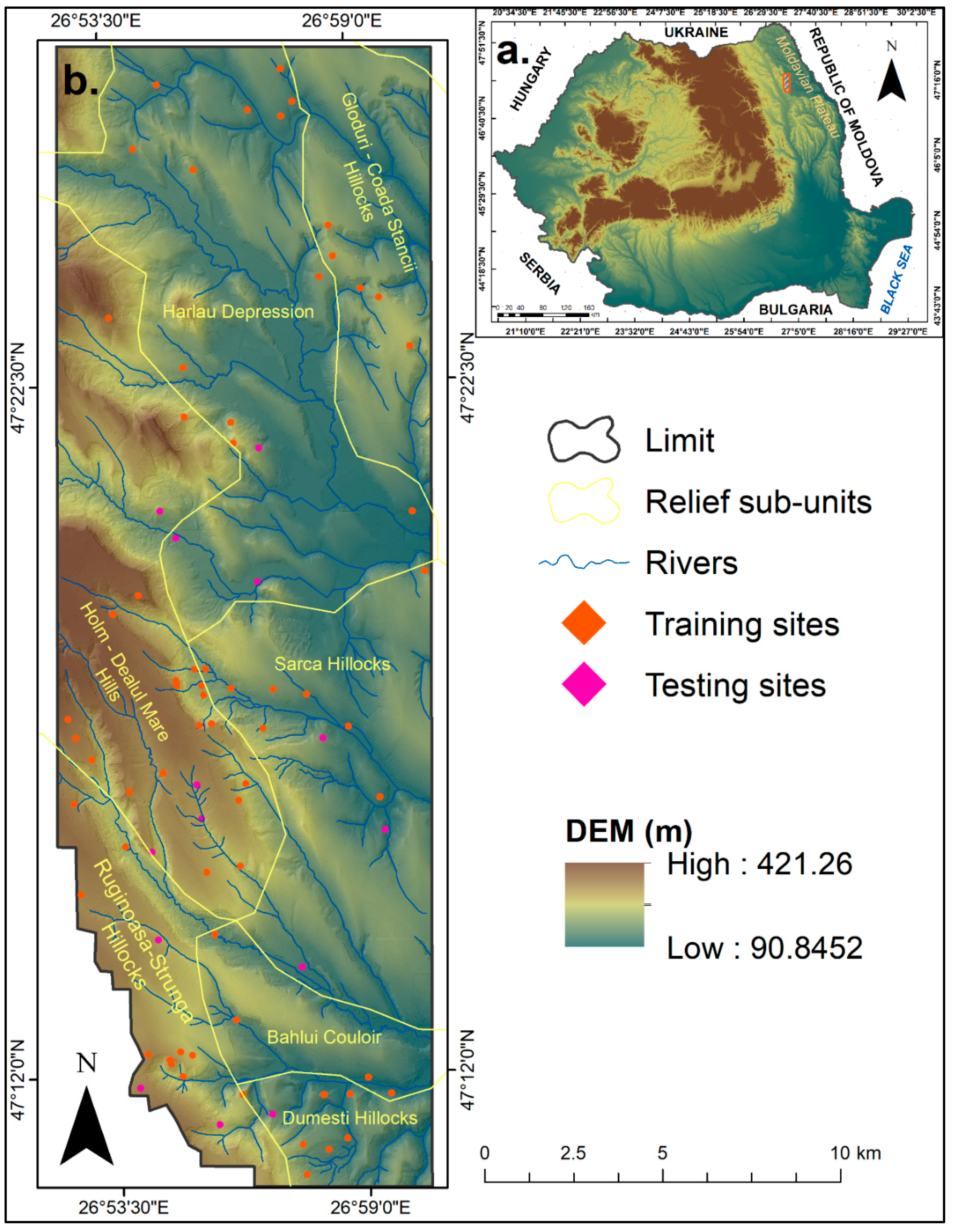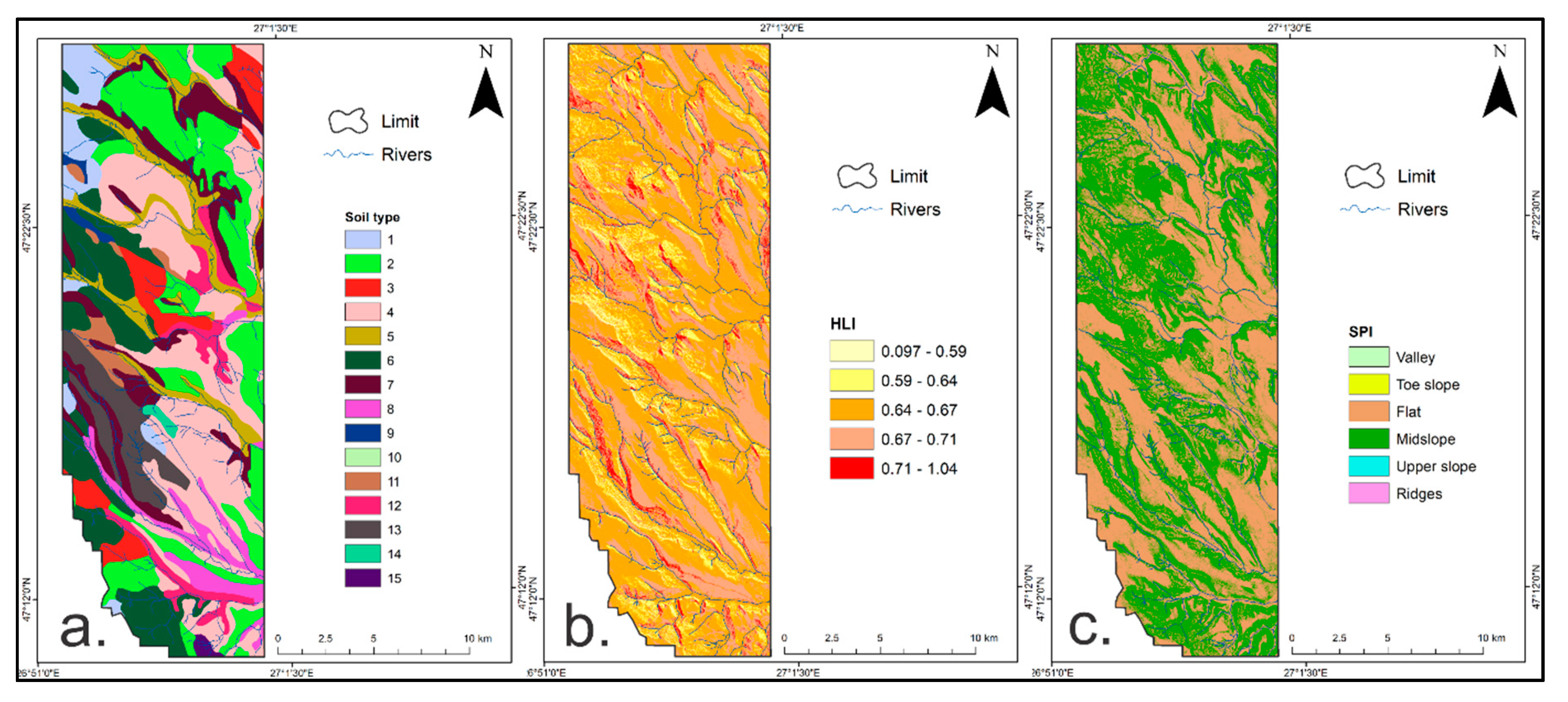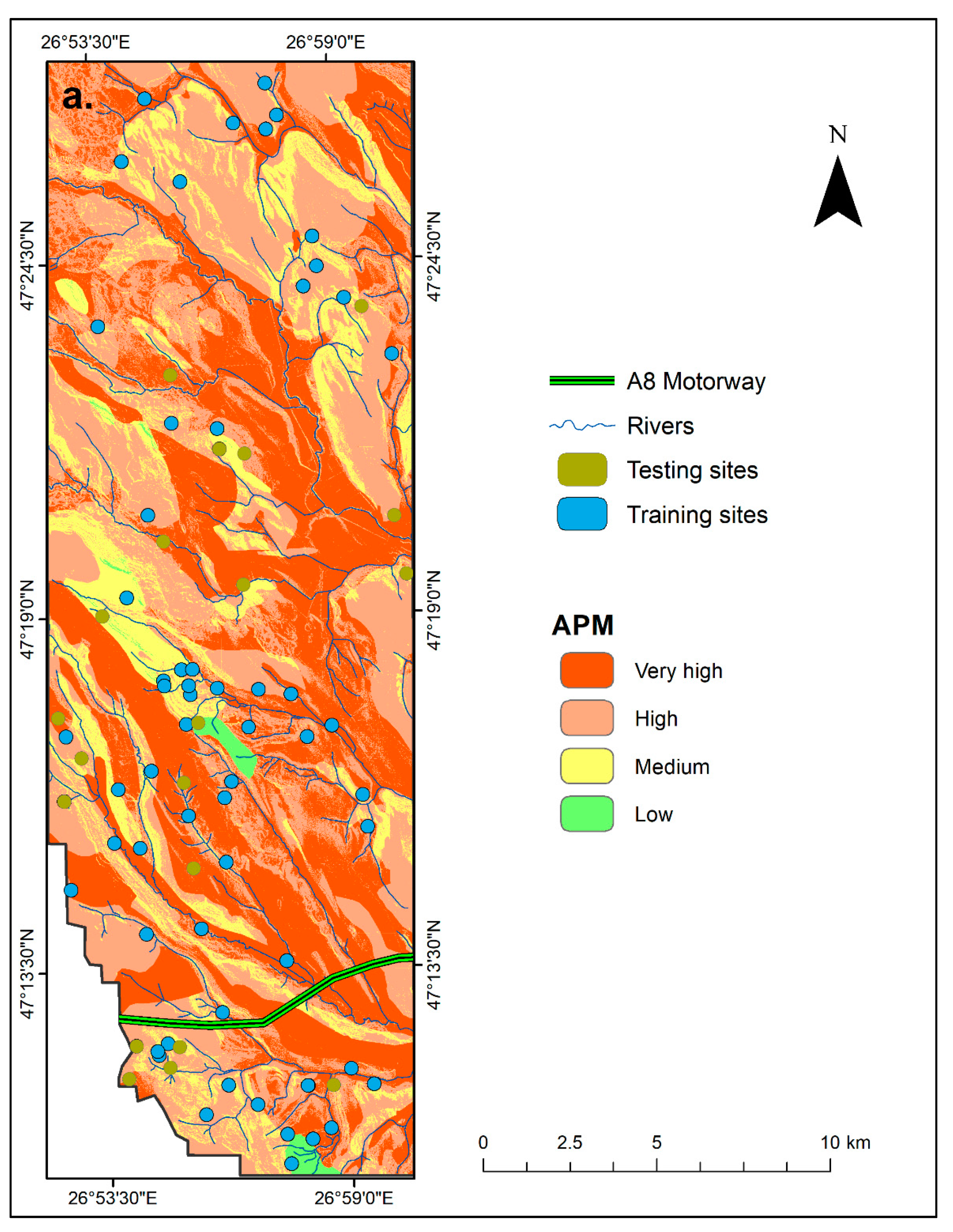GIS-Based and Statistical Approaches in Archaeological Predictive Modelling (NE Romania)
Abstract
1. Research Aims
2. Introduction
3. Archaeological Background and Study Area
4. Materials and Methods
5. Results and Discussion
6. Conclusions
Author Contributions
Funding
Acknowledgments
Conflicts of Interest
References
- Ștefan, D.; Sîrbu, V. Statistical tools in Landscape Archaeology. Archaeol. Calc. 2010, 21, 339–356. [Google Scholar]
- Verhagen, P.; Whitley, T.G. Integrating Archaeological Theory and Predictive Modeling: A Live Report from the Scene. J. Archaeol. Method Theory 2012, 19, 49–100. [Google Scholar] [CrossRef]
- Espa, G.; Benedetti, R.; De Meo, A.; Ricci, U.; Espa, S. GIS based models and estimation methods for the probability of archaeological site location. J. Cult. Herit. 2006, 7, 147–155. [Google Scholar] [CrossRef]
- Danese, M.; Masini, N.; Biscione, M.; Lasaponara, R. Predictive modeling for preventive Archaeology: Overview and case study. Cent. Eur. J. Geosci. 2014, 6, 42–55. [Google Scholar] [CrossRef]
- Howard, A.J.; Knight, D.; Coulthard, T.; Hudson-Edwards, K.; Kossof, D.; Malone, S. Assessing riverine threats to heritage assets posed by future climate change through a geomorphological approach and predictive modelling in the Derwent Valley Mills WHS, UK. J. Cult. Herit. 2016, 19, 387–394. [Google Scholar] [CrossRef]
- Balla, A.; Pavlogeorgatos, G.; Tsiafakis, D.; Pavlidis, G. Recent advances in archaeological predictive modeling for archaeological research and cultural heritage management. Mediterr. Archaeol. Archaeom. 2014, 14, 143–153. [Google Scholar]
- Balla, A.; Pavlogeorgatos, G.; Tsiafakis, D.; Pavlidis, G. Efficient predictive modelling for archaeological research. Mediterr. Archaeol. Archaeom. 2014, 14, 119–129. [Google Scholar]
- Raj, U.; Sinha, N.K.; Tewari, R. National-scale inventory and management of heritage sites and monuments: Advantages and challenges of using geospatial technology. Curr. Sci. India 2017, 113, 1934–1947. [Google Scholar] [CrossRef]
- Nsanziyera, A.F.; Rhinane, H.; Oujaa, A.; Mubea, K. GIS and Remote-Sensing Application in Archaeological Site Mapping in the Awsard Area (Morocco). Geosciences 2018, 8, 207. [Google Scholar] [CrossRef]
- Klehm, C.; Barnes, A.; Follett, F.; Simon, K.; Kiahtipes, C.; Mothulatshipi, S. Toward archaeological predictive modeling in the Bosutswe region of Botswana: Utilizing multispectral satellite imagery to conceptualize ancient landscapes. J. Anthropol. Archaeol. 2019, 54, 68–83. [Google Scholar] [CrossRef]
- Balla, A.; Pavlogeorgatos, G.; Tsiafakis, D.; Pavlidis, G. Locating Macedonian tombs using predictive modelling. J. Cult. Herit. 2013, 14, 403–410. [Google Scholar] [CrossRef]
- Perakis, K.G.; Moysiadis, A.K. Geospatial predictive modelling of the Neolithic archaeological sites of Magnesia in Greece. Int. J. Digit. Earth 2011, 4, 421–433. [Google Scholar] [CrossRef]
- Sánchez, J.C.; Pelgrom, J.; Stek, T.D. Comparing re-surveys in Isernia and Venosa (Molise and Basilicata, Italy). Mediterr. Archaeol. Archaeom. 2017, 17, 39–52. [Google Scholar] [CrossRef]
- Sharafi, S.; Fouladvand, S.; Simpson, I.; Barcelo Alvarez, J.A. Application of pattern recognition in detection of buried archaeological sites based on analysing environmental variables, Khorramabad Plain, West Iran. J. Archaeol. Sci. Rep. 2016, 8, 206–215. [Google Scholar] [CrossRef]
- Zhu, X.; Chen, F.; Guo, H. A Spatial Pattern Analysis of Frontier Passes in China’s Northern Silk Road Region Using a Scale Optimization BLR Archaeological Predictive Model. Heritage 2018, 1, 15–32. [Google Scholar] [CrossRef]
- Vaughn, S.; Crawford, T. A predictive model of archaeological potential: An example from northwestern Belize. Appl. Geogr. 2009, 29, 542–555. [Google Scholar] [CrossRef]
- Duke, D.; King, J. A GIS model for predicting wetland habitat in the Great Basin at the Pleistocene—Holocene transition and implications for Paleoindian archaeology. J. Archaeol. Sci. 2014, 49, 276–291. [Google Scholar] [CrossRef]
- Carleton, W.C.; Cheong, K.F.; Savage, D.; Barry, J.; Conolly, J.; Iannone, G. A comprehensive test of the Locally-Adaptive Model of Archaeological Potential (LAMAP). J. Archaeol. Sci. Rep. 2017, 11, 59–68. [Google Scholar] [CrossRef]
- Noviello, M.; Cafarelli, B.; Calculli, C.; Sarris, A.; Mairota, P. Investigating the distribution of archaeological sites: Multiparametric vs probability models and potentials for remote sensing data. Appl. Geogr. 2018, 95, 34–44. [Google Scholar] [CrossRef]
- Wachtel, I.; Zidon, R.; Garti, S.; Shelach-Lavi, G. Predictive modeling for archaeological site locations: Comparing logistic regression and maximal entropy in north Israel and north-east China. J. Archaeol. Sci. 2018, 92, 28–36. [Google Scholar] [CrossRef]
- Banerjee, R.; Srivastava, P.K.; Pike, A.W.G.; Petropoulos, G.P. Identification of painted rock-shelter sites using GIS integrated with a decision support system and fuzzy logic. ISPRS Int. J. Geo-Inf. 2018, 7, 326. [Google Scholar] [CrossRef]
- Canilao, M.A.P. Weight of evidence predictive modelling and potential locations of ancient gold mining settlements in Benguet in the 16th to 18th centuries. Philipp. J. Sci. 2017, 146, 187–192. [Google Scholar]
- Jarosław, J.; Hildebrandt-Radke, I. Using multivariate statistics and fuzzy logic system to analyse settlement preferences in lowland areas of the temperate zone: An example from the Polish Lowlands. J. Archaeol. Sci. 2009, 36, 2096–2107. [Google Scholar] [CrossRef]
- Verhagen, P.; Dragut, L. Object-based landform delineation and classification from DEMs for archaeological predictive mapping. J. Archaeol. Sci. 2012, 39, 698–703. [Google Scholar] [CrossRef]
- Mihu-Pintilie, A.; Nicu, I.C. GIS-based Landform Classification of Eneolithic Archaeological Sites in the Plateau-plain Transition Zone (NE Romania): Habitation Practices vs. Flood Hazard Perception. Remote Sens. 2019, 11, 915. [Google Scholar] [CrossRef]
- Kaimaris, D. Ancient theaters in Greece and the contribution of geoinformatics to their macroscopic constructional features. Sci. Cult. 2018, 4, 9–25. [Google Scholar] [CrossRef]
- Graves, D. The use of predictive modelling to target Neolithic settlement and occupation activity in mainland Scotland. J. Archaeol. Sci. 2011, 38, 633–656. [Google Scholar] [CrossRef]
- Kamermans, H. Smashing the crystal ball. A critical evaluation of the Dutch National Predictive Model (IKAW). Int. J. Humanit. Arts Comput. 2007, 1, 71–84. [Google Scholar] [CrossRef]
- Asăndulesei, A. Inside a Cucuteni Settlement: Remote Sensing Techniques for Documenting an Unexplored Eneolithic Site from Northeastern Romania. Remote Sens. 2017, 9, 41. [Google Scholar] [CrossRef]
- Nicu, I.C. Cultural heritage assessment and vulnerability using Analytic Hierarchy Process and Geographic Information Systems (Valea Oii catchment, North-eastern Romania). An approach to historical maps. Int. J. Disaster. Risk. Reduct. 2016, 20, 103–111. [Google Scholar] [CrossRef]
- Nicu, I.C.; Asăndulesei, A. GIS-based evaluation of diagnostic areas in landslide susceptibility analysis of Bahluieț River Basin (Moldavian Plateau, NE Romania). Are Neolithic sites in danger? Geomorphology 2018, 314, 27–41. [Google Scholar] [CrossRef]
- Nicu, I.C. Frequency ratio and GIS-based evaluation of landslide susceptibility applied to cultural heritage assessment. J. Cult. Herit. 2017, 28, 172–176. [Google Scholar] [CrossRef]
- Mihu-Pintilie, A.; Asăndulesei, A.; Stoleriu, C.C.; Romanescu, G. GIS methods for assessment of hydro-geomorphic risk and anthropogenic impact which affect the archaeological sites. Case study: Dealul Mare archaeological site, Moldavian Plateau (Romania). Acta Geobalcanica 2016, 2, 35–43. [Google Scholar] [CrossRef]
- Tencariu, F.-A.; Alexianu, M.; Cotiuga, V.; Vasilache, V.; Sandu, I. Briquetage and salt cakes: An experimental approach of a prehistoric technique. J. Archaeol. Sci. 2015, 59, 118–131. [Google Scholar] [CrossRef]
- Brigand, R.; Weller, O. Neolithic and Chalcolithic settlement patterns in central Moldavia (Romania). Doc. Praehist. 2013, 40, 195–207. [Google Scholar] [CrossRef]
- Brigand, R.; Weller, O. Neo-Eneolithic settlement pattern and salt exploitation in Romanian Moldavia. J. Archaeol. Sci. Rep. 2018, 17, 68–78. [Google Scholar] [CrossRef]
- Nicu, I.C. Hydrogeomorphic Risk Analysis Affecting Chalcolithic Archaeological Sites from Valea Oii (Bahlui)Watershed, Northeastern Romania: An Interdisciplinary Approach, 1st ed.; Springer: Cham, The Netherlands, 2016. [Google Scholar] [CrossRef]
- Nicu, I.C. Natural risk assessment and mitigation of cultural heritage sites in North-eastern Romania (Valea Oii river basin). Area 2019, 51, 142–154. [Google Scholar] [CrossRef]
- Nicu, I.C. Tracking natural and anthropic risks from historical maps as a tool for cultural heritage assessment: A case study. Environ. Earth Sci. 2017, 76, 330. [Google Scholar] [CrossRef]
- Ganciu, I. Heritage for Sale! The Role of Museums in Promoting Metal Detecting and Looting in Romania. Heritage 2018, 1, 437–452. [Google Scholar] [CrossRef]
- Bucur, N.; Barbu, N. Complexul de conditii fizico-geografice din <<Coasta Dealul Mare—Harlau>>. Probl. Geogr. 1954, 1, 137–153. [Google Scholar]
- Florea, N.; Munteanu, I. Sistemul Roman de Taxonomie a Solurilor (SRTS); Editura SITECH: Craiova, Romania, 2012. [Google Scholar]
- McCune, B.; Keon, D. Equations for potential annual direct incident radiation and heat load. J. Veg. Sci. 2002, 13, 603–606. [Google Scholar] [CrossRef]
- Jenness, J. Topographic Position Index (tpi_jen.avx) extension for ArcView 3.x, v. 1.2. Jenness Enterprises. Available online: http://www.jennessent.com/arcview/tpi.htm (accessed on 2 October 2019).
- Qi, W.; Yang, X.; Wang, Z.; Li, Z.; Yang, F.; Zheng, Z. Fast landform position classification to improve the accuracy of remote sensing land cover mapping. Earth Sci. 2018, 7, 23–33. [Google Scholar] [CrossRef]
- Nicu, I.C. Application of analytic hierarchy process, frequency ratio, and statistical index to landslide susceptibility: An approach to endangered cultural heritage. Environ. Earth Sci. 2018, 77, 79. [Google Scholar] [CrossRef]
- Youssef, A.M.; Al-Kathery, M.; Pradhan, B. Landslide susceptibility mapping at Al-Hasher Area, Jizan (Saudi Arabia) using GIS-based frequency ratio and index of entropy models. Geosci. J. 2015, 19, 113–134. [Google Scholar] [CrossRef]
- Rosian, G.; Csaba, H.; Kinga-Olga, R.; Botan, C.-N.; Gavrila, I.G. Assessing landslide vulnerability using bivariate statistical analysis and the frequency ratio model. Case study: Transylvanian Plain (Romania). Z. Geomorphol. 2016, 60, 359–371. [Google Scholar] [CrossRef]
- Rahmati, O.; Haghizadeh, A.; Pourghasemi, H.R.; Noormohamadi, F. Gully erosion susceptibility mapping: The role of GIS-based bivariate statistical models and their comparison. Nat. Hazards 2016, 82, 1231–1258. [Google Scholar] [CrossRef]
- Khoshtinat, S.; Aminnejad, B.; Hassanzadeh, Y.; Ahmadi, H. Groundwater potential assessment of the Sero plain using bivariate models of the frequency ratio, Shannon entropy and evidential belief function. J. Earth Syst. Sci. 2019, 128, 152. [Google Scholar] [CrossRef]
- Thapa, R.; Gupta, S.; Kaur, H.; Mandal, R. Assessment of manganese contamination in groundwater using frequency ratio (FR) modeling and GIS: A case study on Burdwan district, West Bengal, India. Model. Earth Syst. Environ. 2018, 4, 161–174. [Google Scholar] [CrossRef]
- Tehrany, M.S.; Kumar, L.; Jebur, M.N.; Shabani, F. Evaluating the application of the statistical index method in flood susceptibility mapping and its comparison with frequency ratio and logistic regression methods. Geomat. Nat. Haz. Risk 2019, 10, 79–101. [Google Scholar] [CrossRef]
- Sahana, M.; Hong, H.Y.; Sajjad, H.; Liu, J.Z.; Zhu, A.X. Assessing deforestation susceptibility to forest ecosystem in Rudraprayag district, India using fragmentation approach and frequency ratio model. Sci. Total Environ. 2018, 627, 1264–1275. [Google Scholar] [CrossRef]
- Monah, D.; Monah, F. The last great Chalcolithic civilization of Old Europe. In Cucuteni. The Last Great Chalcolithic Civilization of Old Europe; Mantu, C.M., Dumitroaia, G.H., Tsaravopoulos, A., Eds.; Athena Publishing & Printing House: Bucharest, Romania, 1997; pp. 15–98. [Google Scholar]
- Lazarovici, C.M.; Lazarovici, G.; Turcanu, S. Cucuteni: A Great Civilization of the Prehistoric World; Editura Palatul Culturii: Iaşi, Romania, 2009; pp. 1–350. [Google Scholar]
- Petrescu-Dîmbovița, M.; Valeanu, M.-C. Cucuteni–Cetățuie. Monografie Arheologică; Editura Constatin Mătasă: Piatra Neamț, Romania, 2004; p. 405. [Google Scholar]
- Enea, S.-C.; Boghian, D.; Ignatescu, S. Anthropomorphic and zoomorphic representations from the Cucuteni sites of Giurgesti and Costesti (Iasi County, Romania). In Cucuteni Culture within the European Neo-Eneolithic Context; Preoteasa, C., Nicola, C.-D., Eds.; Editura “Constantin Matasa”: Piatra-Neamt, Romania, 2016; pp. 533–580. [Google Scholar]
- Rajala, U. ‘We Would Never Have Thought to Go There’–The Changing Definitions of a Site in Central Italian Archaeology. Bull. Hist. Archaeol. 2006, 16, 19–27. [Google Scholar] [CrossRef][Green Version]
- Kvamme, K.L. Development and testing of quantitative models. In Quantifying the Present and Predicting the Past: Theory, Method, and Application of Archaeological Predictive Modelling; Judge, W.J., Sebastian, L., Eds.; U.S. Department of Interior, Bureau of Land Management Service Center: Denver, CO, USA, 1988; pp. 325–428. [Google Scholar]
- Grøn, O. Some problems with modelling the positions of prehistoric hunter-gatherer settlements on the basis of landscape topography. J. Archaeol. Sci. Rep. 2018, 20, 192–199. [Google Scholar] [CrossRef]
- Mertel, A.; Ondrejka, P.; Šabatová, K. Spatial predictive modeling of prehistoric sites in the Bohemian-Moravian Highlands based on graph similarity analysis. Open Geosci. 2018, 10, 261–274. [Google Scholar] [CrossRef]
- Verhagen, P. Case studies in Archaeological Predictive Modelling. Ph.D. Thesis, Leiden University Press, Leiden, The Netherlands, 2007. [Google Scholar]
- Carrer, F. An ethnoarchaeological inductive model for predicting archaeological site location: A case-study of pastoral settlement patterns in the Val di Fiemme and Val di Sole (Trentino, Italian Alps). J. Anthropol. Archaeol. 2013, 32, 54–62. [Google Scholar] [CrossRef]
- Nicu, I.C. Is overgrazing really influencing soil erosion? Water 2018, 10, 1077. [Google Scholar] [CrossRef]





| Conditioning Factor | Class | No. of Pixels in Domain | Pixels % | Sites Pixels | Sites Pixels % | Frequency Ratio (FR) |
|---|---|---|---|---|---|---|
| Soils (type) | 1 Luvisols | 14,818,636 | 4.66 | 74,529 | 3.67 | 0.04 |
| 2 Cambicc Chernozem | 60,267,943 | 18.95 | 527,989 | 26.02 | 0.07 | |
| 3 Clay Chernozem | 15,907,541 | 5.00 | 10,129 | 0.50 | 0.01 | |
| 4 Chernozem | 74,671,552 | 23.47 | 371,852 | 18.33 | 0.04 | |
| 5 Entic Aluviosols | 24,407,123 | 7.67 | 107,480 | 5.30 | 0.04 | |
| 6 Phaeozems | 40,426,881 | 12.71 | 300,325 | 14.80 | 0.06 | |
| 7 Antrosols | 33,237,067 | 10.45 | 318,433 | 15.69 | 0.08 | |
| 8 Gleysols | 13,869,069 | 4.36 | 2134 | 0.11 | - | |
| 9 Regosols | 1,888,710 | 0.59 | - | - | - | |
| 10 Solonetz | 115,847 | 0.04 | - | - | - | |
| 11 Rendzina | 5,965,903 | 1.88 | 81,585 | 4.02 | 0.11 | |
| 12 Aluviosols | 13,567,024 | 4.27 | 82,384 | 4.06 | 0.05 | |
| 13 Stagnosol | 16,705,752 | 5.25 | 85,916 | 4.23 | 0.04 | |
| 14 Bare rock | 1,158,248 | 0.36 | 31,383 | 1.55 | 0.22 | |
| 15 Phaeozems | 1,089,677 | 0.34 | 34,935 | 1.72 | 0.26 | |
| HLI (Heat Load Index) | 0.097–0.59 | 4,898,405 | 1.54 | 54,351 | 2.68 | 0.28 |
| 0.59–0.64 | 35,352,785 | 11.12 | 252,849 | 12.46 | 0.18 | |
| 0.64–0.67 | 154,500,235 | 48.58 | 948,083 | 46.74 | 0.16 | |
| 0.67–0.71 | 108,268,154 | 34.04 | 641,492 | 31.62 | 0.15 | |
| 0.71–1.04 | 15,031,047 | 4.73 | 131,846 | 6.50 | 0.22 | |
| SPI (Slope Position Classification) | 1 Valley | 27,167 | 0.01 | 94 | 0 | 0.09 |
| 2 Toe slope | 162,659 | 0.05 | 1290 | 0.06 | 0.21 | |
| 3 Flat | 175,545,165 | 55.19 | 1,039,526 | 51.24 | 0.15 | |
| 4 Midslope | 142,172,529 | 44.70 | 986,466 | 48.63 | 0.18 | |
| 5 Upper slope | 115,513 | 0.04 | 1115 | 0.05 | 0.25 | |
| 6 Ridges | 27,593 | 0.01 | 130 | 0.01 | 0.12 |
| Class | Pixel Number | Area (%) | Number of Sites | Sites (%) |
|---|---|---|---|---|
| Very high | 114,551,423 | 36 | 23 | 23 |
| High | 146,075,657 | 46 | 41 | 41 |
| Medium | 54,695,517 | 17.1 | 33 | 33 |
| Low | 2,766,013 | 0.9 | 3 | 3 |
| Total | 318,088,610 | 100 | 100 | 100 |
© 2019 by the authors. Licensee MDPI, Basel, Switzerland. This article is an open access article distributed under the terms and conditions of the Creative Commons Attribution (CC BY) license (http://creativecommons.org/licenses/by/4.0/).
Share and Cite
Nicu, I.C.; Mihu-Pintilie, A.; Williamson, J. GIS-Based and Statistical Approaches in Archaeological Predictive Modelling (NE Romania). Sustainability 2019, 11, 5969. https://doi.org/10.3390/su11215969
Nicu IC, Mihu-Pintilie A, Williamson J. GIS-Based and Statistical Approaches in Archaeological Predictive Modelling (NE Romania). Sustainability. 2019; 11(21):5969. https://doi.org/10.3390/su11215969
Chicago/Turabian StyleNicu, Ionut Cristi, Alin Mihu-Pintilie, and James Williamson. 2019. "GIS-Based and Statistical Approaches in Archaeological Predictive Modelling (NE Romania)" Sustainability 11, no. 21: 5969. https://doi.org/10.3390/su11215969
APA StyleNicu, I. C., Mihu-Pintilie, A., & Williamson, J. (2019). GIS-Based and Statistical Approaches in Archaeological Predictive Modelling (NE Romania). Sustainability, 11(21), 5969. https://doi.org/10.3390/su11215969







